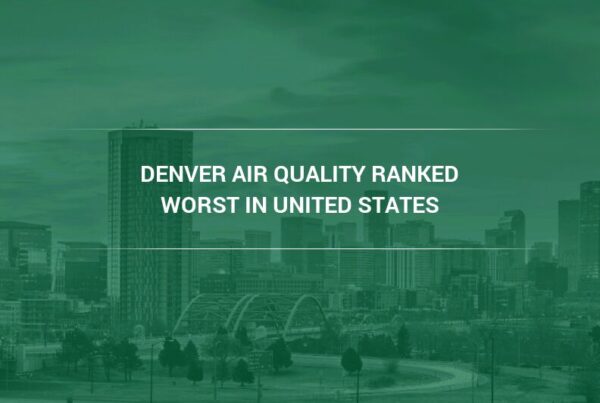2020 and 2021 experienced some of the most severe wildfires in the nation’s history and some experts predict that 2022 may be even worse.
Wildfires are usually at their peak in June through August. This year, the combination of labor shortages and extreme drought conditions in Oregon is likely to produce especially tough conditions (1). Across the United States, more than 1.3 million acres of woodland have already burned in 2022 (2). Colorado scientists have identified new carbon monoxide-related health issues as a result of wildfire smoke from last August (3). Since last year’s wildfire season, new evidence has shown that exposure to pollutants from wildfire smoke increases the likelihood of contracting and experiencing severe complications, including death from COVID-19 (4).
In this article, air quality experts from Camfil give advice on staying safe from the health risks associated with wildfire smoke this summer.
What Pollutants Are Found in Wildfire Smoke?
Because wildfires involve the combustion — both complete and incomplete — of organic and other substances, wildfire smoke contains a range of pollutants.
Pollutants in the air are broadly divided into two categories: gaseous pollutants and particulate matter.
The gaseous pollutants in wildfire smoke may vary depending on what was burned, but the most common gaseous pollutants found in wildfires include:
- ozone
- sulfur dioxide
- nitrogen oxides
- carbon monoxide
- carbon dioxide
- volatile organics compounds (VOCs)
- water vapor
The other category of pollutant is particulate matter. Particulate matter is defined as any solid or liquid particle small enough to remain suspended in the air. Particulate matter is a common result of the combustion processes that occur in wildfires.
West coast states, particularly California, repeatedly rank among the most highly polluted areas in the country. Though much of this pollution is attributed to car exhaust and industrial fumes, ozone and particulate matter, two of the most problematic pollutants present in California’s air, are common byproducts of wildfire smoke.
7 Tips for Staying Healthy During Wildfire Season from Air Quality Experts
In the United States, wildfires primarily affect the west coast and northern states. However, wildfire smoke can be carried hundreds and even thousands of miles by the wind, causing hazy conditions and poor air quality far away from the site of the fire.
For this reason, it is important to consider the effects of wildfire smoke and have a plan to account for air quality advisories in your area this wildfire season, even if you do not live in an area directly affected by wildfires.
- Stay indoors when there is an air quality advisory in your area, or when there is visible haze in the air. Even if a wildfire isn’t occurring in your immediate area, wildfire smoke disperses, affecting air quality thousands of miles from the site of combustion. Keep your doors and windows closed under these conditions for the same reasons.
- Reduce the time you spend outdoors under air quality advisories or when there is visible haze in the air.
- Avoid exercising outdoors, particularly running and hiking. These activities require more frequent, deeper breathing to circulate the necessary oxygen around your body, which unfortunately means also breathing in more harmful pollutants.
- Visit indoor spaces with a controlled, properly filtered air supply. Although under normal conditions more ventilation and circulation is better, during spikes in poor air quality, it is important that outdoor air is properly filtered before it comes inside.
- Maintain adequate filtration in your house. In addition to helping clean the air youbreathe, this is crucial because most HVAC systems are not equipped to handle the extreme levels of pollution associated with wildfire smoke. The panel and fiberglass filters found in HVAC systems are there to protect the equipment from being damaged by normal amounts of pollution in the air. During wildfire season, you may find that you need to change your HVAC air filters more frequently.
- Use an air purifier to supplement your HVAC system’s filtration. Most residential HVAC systems are not equipped to handle filters deep enough to deliver a high level of rated efficiency, which would protect your health from any pollution that works its way indoors. Fortunately, stand-alone HEPA filtration air purifier units can provide adequate filtration. Camfil’s City M air purifier uses both HEPA filtration and activated carbon filtration to target both particulate matter and gaseous pollutants.
About Camfil Clean Air Solutions
For more than half a century, Camfil has been helping people breathe cleaner air. As a leading manufacturer of premium clean air solutions, we provide commercial and industrial systems for air filtration and air pollution control that improve worker and equipment productivity, minimize energy use, and benefit human health and the environment. We firmly believe that the best solutions for our customers are the best solutions for our planet, too. That’s why every step of the way – from design to delivery and across the product life cycle – we consider the impact of what we do on people and on the world around us. Through a fresh approach to problem-solving, innovative design, precise process control, and a strong customer focus we aim to conserve more, use less and find better ways – so we can all breathe easier.
The Camfil Group is headquartered in Stockholm, Sweden, and has 31 manufacturing sites, six R&D centers, local sales offices in 35+ countries, and about 5,200 employees and growing. We proudly serve and support customers in a wide variety of industries and in communities across the world. To discover how Camfil USA can help you to protect people, processes and the environment, visit us at www.camfil.us/
##
Media Contact:
Lynne Laake
Camfil USA Air Filters
T: 888.599.6620
E: Lynne.Laake@camfil.com
F: Friend Camfil USA on Facebook
T: Follow Camfil USA on Twitter
Y: Watch Camfil Videos on YouTube
L: Follow our LinkedIn Page
Sources:
- https://oregoncapitalchronicle.com/2022/05/16/oregon-gov-brown-fire-officials-warn-of-challenging-2022-wildfire-season/
- https://www.theguardian.com/us-news/2022/may/13/us-wildfires-california-new-mexico-burning-early-2022
- https://www.9news.com/article/weather/weather-colorado/air-pollution-carbon-monoxide-wildfire-smoke/73-a57b27c3-a4c2-4628-bfeb-44bdc3645380
- https://cleanair.camfil.us/2021/05/02/air-filtration-experts-share-advice-for-the-upcoming-wildfire-season/



